How To Stop Moths Eating Your Clothes - 10 Steps To Clothes Moth Prevention

One of the most common questions customers ask is “Do moths eat clothes?”
The rapidly increasing presence of clothes moths is risking damage to your precious clothing. Hopefully you will find the resources on this website helpful in increasing your understanding of the issues, as well as giving you the knowledge to tackle any incidence of clothes moths appearing in your home.
If you suspect a clothes moth infestation in your home, the number one thought should be, act fast; clothes moths breed really rapidly and with a short lifecycle, you may be alarmed at how quickly they multiply.
Step 1 - Identify the Clothes Moth
The webbing clothes moth is the most likely clothes moth you will find, followed by the case-bearing clothes moth which will attack carpets and clothes. Brown house moths and white-shouldered moths are less common but potentially equally damaging.
It is important to distinguish between clothes moths and pantry moths - they are attracted to very different pheromones / moth traps. It is unlikely that you’ll have pantry moths in your closets or bedrooms but in living areas you may have one or both types. Our solution to vacating pantry moths from your home is picking up some of our pantry moth traps.
See the moth identification guides on this site for more information.
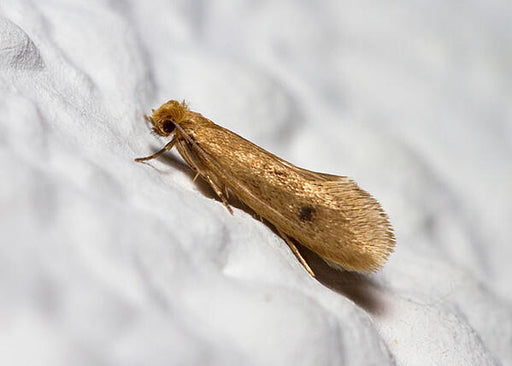
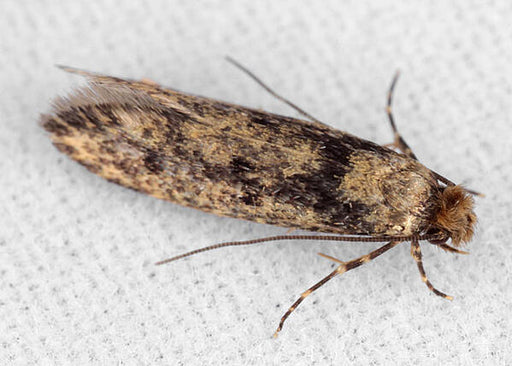
Step 2 - Assess the intensity of your fabric moth infestation
Use Clothes Moth Traps to identify how much of a problem you may have - unlike many other types of moths, clothes moths prefer dark, undisturbed places (think closets!) and you most likely need the assistance of pheromone moth traps to get an idea of the level of infestation you are really dealing with.
Clothes moth traps also only catch the adult active male moths by using the female pheromone to attract them. They help to contain growth in numbers of the clothes moths in your home by taking the males out of the breeding cycle.
Step 3 - Cleaning Closets, Drawers, and Wardrobes where Moths can live
Dust is likely to attract clothes moths - dust has a high content of human hair, and the skin cells that we shed every day - keratin included!
Are your closets and shelves stuffed to bursting with clothes? Do you vacuum and dust your closets, shelves and drawers regularly? Do you ever take out your clothes and shake and air them?
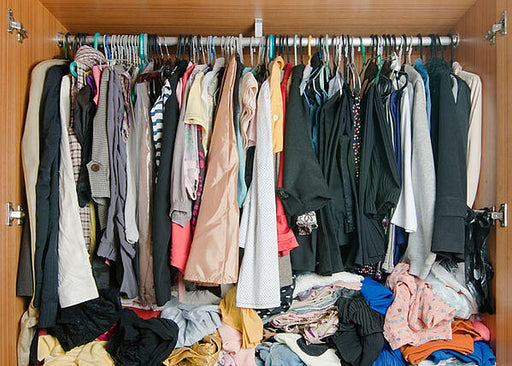
There are clues here in answering “how do I stop moths eating my clothes?”. Clothes moths like to be undisturbed. They like dark places. Clothing that is only occasionally touched and / or removed from the closet is at highest risk.
We would highly recommend that you do not overfill your closets and drawers, and that your home cleaning routines include vacuuming any clothes storage furniture - both the floors and the walls / sides, whether built-in or freestanding closets, and inside drawers and shelves. Check out our post on clothes organization tips.
Also look under furniture and vacuum there regularly - we find a large number of clothes moth infestations start in wool carpets and then transfer to clothing in closets. Likewise along baseboards, behind doors and other potential undisturbed, and likely unseen areas. Under furniture (beds, sofas, free-standing storage units etc) is the most likely place for clothes moths to lie undetected for longer periods - they can multiply unseen, and obviously the larvae cause damage, before you have noticed them.
Lastly, when vacuuming, empty your vacuum cleaner outside into a bag that is then tied tight and disposed of in the trash to avoid the risk of any moth eggs and or larvae remaining in the home.
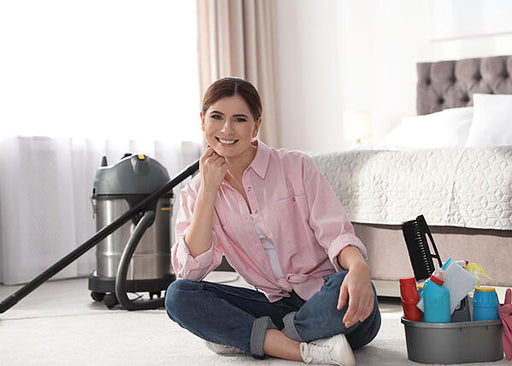
Step 4 - Reduce the breeding of clothes moths in your home
If you get the right clothes moth traps and act fast then you MAY stop them getting to lay eggs on your clothing. At the least you will contain the problem and reduce the amount of damaged clothing.
Remember, it is the clothes moth larvae that hatch from the eggs that do the damage to your clothes - adult flying clothes moths do not eat, but if they are able to mate, the females then lay hundreds of eggs in their short lifetime. Eggs hatch into larvae and larvae pupate into clothes moths.
Depending on temperatures and humidity conditions, clothes moth larvae can live for up to 30 months (eating your clothes!) - that’s for colder climates. In warmer areas they can go from egg to pupation into adults in little over a month. Either way, given its the larvae that do the damage, your clothes will NOT be safe if clothes moth larvae are present in your closets.
For information on eliminating larger infestations in your home, you may like to read our Clothes Moth Kit Guide, which gives you guidance about using chemical products in line with our Traps.
Step 5 - Check your clothing for moth holes and moth larvae
What do clothes moths eat? Clothes moth larvae only eat Keratin - the protein in natural animal based fibers - they will NOT eat cotton and synthetic fabrics unless they are heavily soiled in food or sweat. Look for signs of damage in woolens, silk and any feather, fur or soft leather items. Think cashmere sweaters and Ugg boots for example - sadly the most expensive items of clothing in your closets, and the softest materials, will be at greatest risk. You are unlikely to easily spot the eggs - they are tiny, but you may see some larvae before they pupate and turn into adult moths. See our clothes moths identification guide for more information. You may also see some very fine sticky webbing on your clothes or in nearby carpets.
Look for signs of damage - irregular holes are the obvious tell-tale signs, although some fibers from your beloved cashmere sweater may have been eaten without creating obvious visible holes. You need to look really closely and look for fibers that may fall away from your clothing.
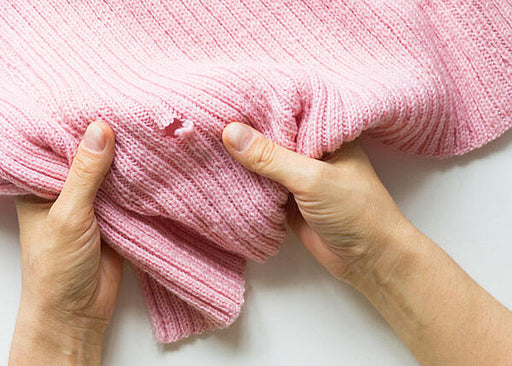
Step 6 - Cleaning Clothes
Human sweat and food stains will also attract clothes moths to your clothes - regular cleaning is essential.
Hot washes in a domestic washing machine are often not practical for the very items you need to protect - fine knitwear will shrink, coats for obvious reasons, silk can get damaged.
All clothes should be taken outside and shaken to begin with before taking the next step. This also gives you empty space to thoroughly vacuum, dust and, if necessary, apply specialist treatments to clothes storage areas (closets, drawers, shelving etc).

Step 7 - Eliminate moth eggs & moth larvae
Dry cleaning is one weapon in your armory; deep freezing is another, after you’ve placed the clothing in sealed bags and ensured that they are frozen for at least 72 hours, and preferably a week. A chest freezer is ideal for this.
You may hear that exposing the clothes to sunlight will deal with larvae; this is not true. As is turning up your heating to maximum - this may just trigger larvae to turn into moths given an increase in the ambient temperature in the spring is usually the start of ‘moth season’. What you now know though is that the active season is not necessarily the only time that damage will occur to your clothes.
If you have a larger or persistent moth infestation Clothes Moth Kit Guide gives you useful guidance on using chemical moth-killing solutions within the home.
Step 8 - Ongoing Moth Lifecycle
Keep alert to the possible return of clothes moths - to do so we would recommend keeping moth protection for clothes in place and active (remember that the pheromone boards have a 12 weeks effective life in emitting the female clothes moth pheromone). This is particularly important during the peak moth season from March through November when the warmer weather triggers the breeding cycle and you are most likely to see adult moths flying.
Remember that you will not catch all flying clothes moths in these moth traps - the female pheromone will not catch female or juvenile clothes moths, only sexually active male moths.
Step 9 - Clothes Storage
Most of us effectively have “two wardrobes” for spring / summer and fall / winter - the correct storage of clothes ‘out of season’ is critical in your defending against moths eating your clothes! The seasonal changeover also gives you a great opportunity to clear out your closets and drawers to get to the clear spaces and perform the cleaning and treatment that is described above.
When clearing out your previous season clothes, you can check for evidence of clothes moth activity and, importantly, evidence of eggs and larvae.
All clothes should be stored clean and dry (clothes moth larvae need moisture as well as the keratin in your clothes). We would recommend using vacuum sealed bags to prevent any female clothes moths laying eggs while these clothes are stored for a number of months.
You may have heard of suggestions to store with lavender or cedar fragranced bags - this will not be necessary if the clothes are vacuum sealed.
Whatever you do, please avoid hanging off-season garments in wardrobes, attics or other undisturbed areas that will provide ideal conditions for clothes moth larvae to eat your clothes!
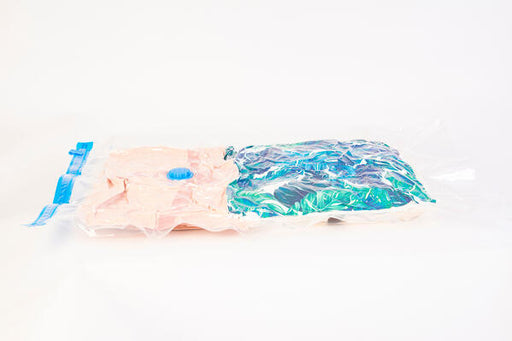
Step 10 - Continue to monitor for presence of moths
Prevention is better than cure! Be vigilant.
If you have suffered damage, you may want to keep clothes moth control traps in place throughout the season (March to November) to monitor their potential presence. In warmer Southern States from Florida across to Texas and then to California, clothes moths are often a year-round problem.
FAQs on How to Stop Moths From Eating Clothes, and Other Moth Prevention Tips
Moths in your house can be very frustrating. After all, no one wants moth holes in clothes! If you are wondering how to stop moths from eating your favorite sweaters, scarves, or precious textiles, you are in luck! Here are some helpful tips to get rid of these pests.
Do moths eat clothes?
It’s a common misconception that Moths eat clothes but it is actually their hungry Larvae that do the damage. For instance, Clothes Moth Larvae eat natural fibers that contain keratin, a protein found in animal based fibers.
Adult female Clothes Moths are attracted to quiet, dark, secluded places where these materials can be found as a food source for their larvae. In nature, Clothes Moths lay eggs near bird nests, animal carcasses, and the like. These eggs then hatch into hungry larvae and can be very destructive.
How to stop moths from eating clothes?
So how to stop moths from eating your clothes? First, know your enemy. It is the Clothes Moth Larvae who are the ravenous little critters. They like to hide in dark, secluded areas and will avoid places with lots of natural light or airflow. So, if you are looking for moth larvae (or eggs), start by searching in cracks, crevices, behind furniture, or underneath rugs. Then, you should thoroughly clean to eliminate all adults, eggs, and larvae in your home. After cleaning all infested areas well, use Moth Traps and natural oils to prevent a re-infestation.
What is the best deterrent for moths?
Cedar is a great moth-deterrent. Consider buying cedar chests, wardrobes, or shelving to give your closets a fresh scent and keep moths away. You can also deter moths using natural herbs like lavender, rosemary, thyme, cloves, and mint.
What kills clothing moths?
Moths that eat clothing are relatively easy to kill. You can freeze any items of clothing that are infested with larvae or contain eggs. For information on sprays and foggers for larger infestations you may like to read our Clothes Moth Kit Guide and our Carpet Moth Kit Guide which gives you guidance about using chemical products in line with our Traps. When killing Clothes Moths, the trick is making sure that you treat all potentially infested areas exhaustively.
Why do moths keep eating my clothes?
The worm-like larvae of the Clothes Moth tunnel through animal based fibers as they eat them. They thrive on fabrics such as wool, cashmere, silk, and sometimes cotton. In the larval stage, Clothes Moths can even damage leather and feathers. They will also eat plant based materials if they have sweat or blood stains on them. If you keep getting moths in your home, ask yourself these questions:
- Are you bringing in infested items from thrift stores?
- Are moth eggs hidden somewhere hard to locate?
- Do you frequently leave your windows or doors open?
- Do you have an attic or chimney?
If you keep getting Clothes Moth Larvae infestations, you may have an underlying infestation thriving somewhere hidden. As such, you should consider storing your garments differently, cleaning all secluded areas and consulting our Clothes Moth Kit Guide on chemical methods to rid your home of moths.
How do you get rid of Clothes Moths naturally?
There are many natural ways to eliminate Clothes Moths. If you are in the prevention stage, consider using Cedar shelving and natural herbal sachets to deter Clothes Moths. Fashion these sachets using herbs like rosemary, lavender, thyme, mint, and Cedar pellets, to keep moths from visiting your closets or other small spaces where you keep garments, bedding, rugs, or decor. Always keep natural deterrents far away from Moth Traps because they can interfere with the Trap pheromones.
How Do I Stop Moths Eating My Clothes? Final Thoughts
We hope this article has answered the question “How do I stop moths eating my clothes?” - it may feel like a lot of work to do this thoroughly, and some expense, but it will save your clothes and a lot of money in damage to them. You could ask a professional pest controller to apply a treatment although many customers do not want someone working in their bedrooms and closets or the significant cost.
Plus hopefully you will now appreciate that dealing with, and preventing the return of, clothes moths requires ongoing monitoring and routines to help you stop moths eating your clothes longer term.
About MothPrevention
MothPrevention® speak to customers every day about their clothes moth issues - clothes moths are a species that are ever increasing and that can cause significant damage to clothes, carpets and other home textiles.
To date, we’ve helped over 250,000 customers deal with their moth problems. We have developed professional grade solutions including proprietary pheromones and trap design, not available from anybody else in the USA.





